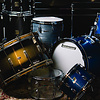It’s not exactly easy for most folks to practice their drums at full-volume right now. Many of us find ourselves with more time on our hands and are experiencing the perfect opportunity to work on getting our hands in time. I imagine most drummers are utilizing some sort of quiet practice tools so they can play in peace without disturbing their neighbors/roommates/spouses during the day. We shouldn’t let the volume of our instruments prevent us from practicing. With that said, I wanted to review a couple of items that have helped me get more quality, focused practicing done during this strange time.
- Remo Silent Stroke Drum Heads are single-ply mesh heads that make virtually no noise. These are perfect for apartment-dwelling drummers that want to play their full kit. These heads also offer a ton of rebound and feel great to play. You can also add gaffer’s tape to increase the volume and articulation of the heads, which is beneficial when using ghost notes or feathering the bass drum.
- Vic Firth Double or Single-Sided 12” Practice Pad-Practice pads have always been essential and affordable practice tools for any drummer or percussionist. It’s always important to focus on timing and technique in the hands to facilitate making great music on the drums.
- Prologix Light Resistance Green 12” Practice Pad-These practice pads are also 12” in diameter, but also offer a realistic hoop for rim shots or clicks. The pad material has more resistance than traditional practice pads, making the hands and wrists work harder for quicker chop building.
- Prologix Tenor Pro Practice Pad-If you play marching tenors, you know that not too much work can be done with just a single practice pad. Prologix offers these in either five or six-drum configurations, with accurate spacing between each pad.
- Sabian Quiet Tone Cymbals are perforated stainless steel cymbals and optimal practice tools. They reduce almost all volume while still sounding similar to standard cymbals. Quiet Tones feel great to play, making them possibly the best option for quiet practice. These cymbals make little more sound than a practice pad.
- Roland V-Drums are the ultimate practice(and performance) tool, regardless of the global crisis. I’m referring to Roland’s line of electronic drum kits, which are probably the most advanced on the market due to their superior triggering. I won’t lay out all of the features of each model as they have a wide range of them that cost anywhere from $699-$6999, but these kits are well worth the investment. Almost every model features durable double-ply mesh heads for excellent feel and realistic rebound. Even an entry-level sound module comes standard with a wide selection of acoustic and electronic drum sounds that are expanded with more advanced models. The built-in coaching functions and metronome are great features for anyone looking to improve their playing.
I also wanted to mention a few great method books that have helped me grow a lot as a player. Even spending a few minutes a day working through one book can greatly improve your playing and give you a new musical perspective.
- Stick Control by George Lawrence Stone might be the most important method book for any drummer or percussionist to own. As the title suggests, this book contains exercises designed to condition the hands and slowly build more muscle control. This serves as a great foundation for any style of playing.
- Accents and Rebounds by George L. Stone is the sequel to Stick Control. It builds on the concepts of Stick Control by incorporating accents and taps, as opposed to playing the exercises at one dynamic level.
- The Funky Primer for the Rock Drummer by Charles Dowd-This is another classic book that is still widely utilized by teachers. Don’t let the title fool you, these exercises provide a strong foundation for drum set playing in any musical context. I would recommend this book to all beginning or intermediate drummers.
- Advanced Funk Studies by Rick Latham-To work through this book, it does help to have a solid base knowledge of basic drumming concepts. With these exercises you’ll work on independence and timing between limbs, all in the context of a groove. This method book also has a plethora of transcriptions from notable fusion and funk drummers.
- The Art of Bop Drumming by John Riley- Although drummers from any style should have the same general basic skills, different styles indeed require different approaches to the drums. A brief example is that in rock drumming, the groove is centered around the bass drum and snare drum while the ride cymbal and hi-hats drive the groove in a jazz setting. John Riley dives deep into this concept and lays out the blueprints for jazz drumming while combining the knowledge of several master drummers in this excellent sourcebook.
This can be a time where we play more instead of less, all we need are the right tools. Don’t forget to shop local during this trying time, and feel free to comment on this post with any questions!





 Upbeat Drum Lessons Denver
Upbeat Drum Lessons Denver
 ABOUT
ABOUT
 Accessories
Accessories
 Apparel
Apparel
 Cymbals
Cymbals
 Drums
Drums
 Hardware
Hardware
 Percussion
Percussion
 More Services
More Services
 SPECIALS
SPECIALS
 Used/Vintage
Used/Vintage
 5280 Drum Blog
5280 Drum Blog










